Today the AD line, On Balance Volume and inverted VIX give signals which support alternate Elliott wave counts. Price remains range bound. The alternate Elliott wave counts expect the same direction for the breakout.
Summary: A new low below 2,822.12 would indicate a continuing deeper pullback as fairly likely, as outlined by the alternate wave counts. The first target would then be at 2,663. Today bearish signals from the AD line, inverted VIX and On Balance Volume support this view.
An upwards breakout above 2,940 with support from volume is now required for confidence in the main wave count. If this happens, then the next target is 3,120.
The biggest picture, Grand Super Cycle analysis, is here.
Monthly charts were last published here, with video here. There are two further alternate monthly charts here, with video here.
ELLIOTT WAVE COUNTS
The two weekly Elliott wave counts below will be labelled First and Second. They may be about of even probability. When the fifth wave currently unfolding on weekly charts may be complete, then these two wave counts will diverge on the severity of the expected following bear market. To see an illustration of this future divergence monthly charts should be viewed.
FIRST WAVE COUNT
WEEKLY CHART
The basic Elliott wave structure consists of a five wave structure up followed by a three wave structure down (for a bull market). This wave count sees the bull market beginning in March 2009 as an incomplete five wave impulse and now within the last fifth wave, which is labelled cycle wave V. This impulse is best viewed on monthly charts. The weekly chart focusses on the end of it.
Elliott wave is fractal. This fifth wave labelled cycle wave V may end a larger fifth wave labelled Super Cycle wave (V), which may end a larger first wave labelled Grand Super Cycle wave I.
The teal Elliott channel is drawn using Elliott’s first technique about the impulse of Super Cycle wave (V). Draw the first trend line from the end of cycle wave I (off to the left of the chart, the weekly candlestick beginning 30th November 2014) to the end of cycle wave III, then place a parallel copy on the end of cycle wave II. This channel perfectly shows where cycle wave IV ended at support. The strongest portion of cycle wave III, the end of primary wave 3, overshoots the upper edge of the channel. This is a typical look for a third wave and suggests the channel is drawn correctly and the way the impulse is counted is correct.
Within Super Cycle wave (V), cycle wave III is shorter than cycle wave I. A core Elliott wave rule states that a third wave may never be the shortest. For this rule to be met in this instance, cycle wave V may not be longer in length than cycle wave III. This limit is at 3,477.39.
Cycle wave V may subdivide either as an impulse or an ending diagonal. Impulses are much more common. This main wave count expects that cycle wave V may be unfolding as an impulse.
The daily charts below will now focus on all of cycle wave V.
In historic analysis, two further monthly charts have been published that do not have a limit to upwards movement and are more bullish than this wave count. Members are encouraged to consider those possibilities (links below summary) alongside the wave counts presented on a daily and weekly basis.
MAIN DAILY CHART
Today there is less support from classic technical analysis for this wave count. It remains valid and still has some support, but the situation is unclear. The alternate wave counts must be seriously considered alongside this main wave count.
Cycle wave V is seen as an impulse for this wave count.
Within cycle wave V, primary waves 1 and 2 may be complete. Primary wave 3 may have begun.
Primary wave 3 may only subdivide as an impulse. Within primary wave 3, intermediate waves (1) and (2) may be complete.
It is also possible that intermediate wave (2) may be incomplete and sideways movement of the last 16 sessions may be minor wave B within a zigzag for intermediate wave (2). If intermediate wave (2) continues lower, then it may not move beyond the start of intermediate wave (1) below 2,728.81.
Intermediate wave (3) may have begun. Intermediate wave (3) may only subdivide as an impulse.
MAIN HOURLY CHART
Intermediate wave (3) may only subdivide as a five wave impulse. Within intermediate wave (3), minor waves 1 and 2 may now be complete. Minor wave 3 may only subdivide as a five wave impulse.
Within minor wave 3, minute waves i and ii may be complete. Within minute wave iii, minuette wave (ii) may not move beyond the start of minuette wave (i) below 2,834.97.
Minute wave iii must move beyond the end of minute wave i. Minute wave iii must move far enough above the end of minute wave i to allow room for minute wave iv to unfold and remain above first wave price territory.
The next wave up for this wave count may then exhibit an increase in momentum as a third wave at four degrees unfolds.
ALTERNATE DAILY CHART
This first alternate wave count considers the possibility that cycle wave V may be unfolding as an impulse.
Cycle wave V must subdivide as a five wave motive structure. Within that five wave structure, primary wave 1 only may be complete.
Primary wave 2 may be unfolding as an expanded flat correction. These are reasonably common Elliott wave corrective structures. Flat corrections subdivide 3-3-5. Expanded flats have B waves which are 1.05 or more the length of their A waves. In this example for primary wave 2, intermediate wave (B) is a 1.33 length of intermediate wave (A). The target for intermediate wave (C) expects it to exhibit the most common Fibonacci Ratio to intermediate wave (A) within an expanded flat.
If price reaches the target at 2,663 and keeps falling, then the next target would be the 0.618 Fibonacci Ratio of primary wave 1 at 2,578.66.
Primary wave 2 may not move beyond the start of primary wave 1 below 2,346.58.
ALTERNATE HOURLY CHART
Intermediate wave (C) must subdivide as a five wave motive structure for this wave count. Minor waves 1 and 2 may be complete within intermediate wave (C).
Minor wave 3 may only subdivide as an impulse. Minute waves i and ii may be complete within minor wave 3.
Minute wave iii may only subdivide as an impulse. Minuette wave (i) may be incomplete within minute wave iii. Minuette wave (ii) may not move into minuette wave (i) price territory above 2,939.08.
SECOND ALTERNATE DAILY CHART
This second alternate daily chart considers the other structural possibility for cycle wave V, that of an ending diagonal. Ending diagonals in fifth wave positions are not as common as impulses; for this reason, this wave count will remain an alternate until an impulse for cycle wave V is invalidated.
All sub-waves within an ending diagonal must subdivide as zigzags. Primary wave 1 may have been complete as a zigzag at the last all time high on the 26th of July.
Primary wave 2 may be continuing lower as a zigzag. Within the zigzag, intermediate wave (B) may be completing as a sideways triangle.
Within diagonals, sub-waves 2 and 4 are normally very deep, ending within a range of 0.66 to 0.81 the prior wave. This range for primary wave 2 is from 2,578 to 2,476. Primary wave 2 may possibly come as low as the lower edge of the teal channel, which is copied over from the weekly chart.
Primary wave 2 may not move beyond the start of primary wave 1 below 2,346.58.
SECOND ALTERNATE HOURLY CHART
Within the zigzag of primary wave 2, intermediate wave (B) may be subdividing as a regular contracting triangle. Only the final sub-wave of minor wave E may be needed to complete.
Minor wave E should subdivide as a single zigzag and would most likely fall short of the upper A-C trend line. Minor wave E may not move beyond the end of minor wave C above 2,939.08. A target is now calculated for minor wave E to end that would see it fall a little short of the A-C trend line and expects a common Fibonacci Ratio between minute waves a and c within it.
If the triangle is invalidated with a new high by any amount at any time frame above 2,939.08, then intermediate wave (B) may be completing as a double combination: zigzag – X – flat. A new high above 2,939.08 does not invalidate this wave count.
When the triangle is complete, then intermediate wave (C) downwards should begin.
SECOND WAVE COUNT
WEEKLY CHART
This weekly chart is almost identical to the first weekly chart, with the sole exception being the degree of labelling.
This weekly chart moves the degree of labelling for the impulse beginning in March 2009 all down one degree. This difference is best viewed on monthly charts.
The impulse is still viewed as nearing an end; a fifth wave is still seen as needing to complete higher. This wave count labels it primary wave 5.
TECHNICAL ANALYSIS
WEEKLY CHART
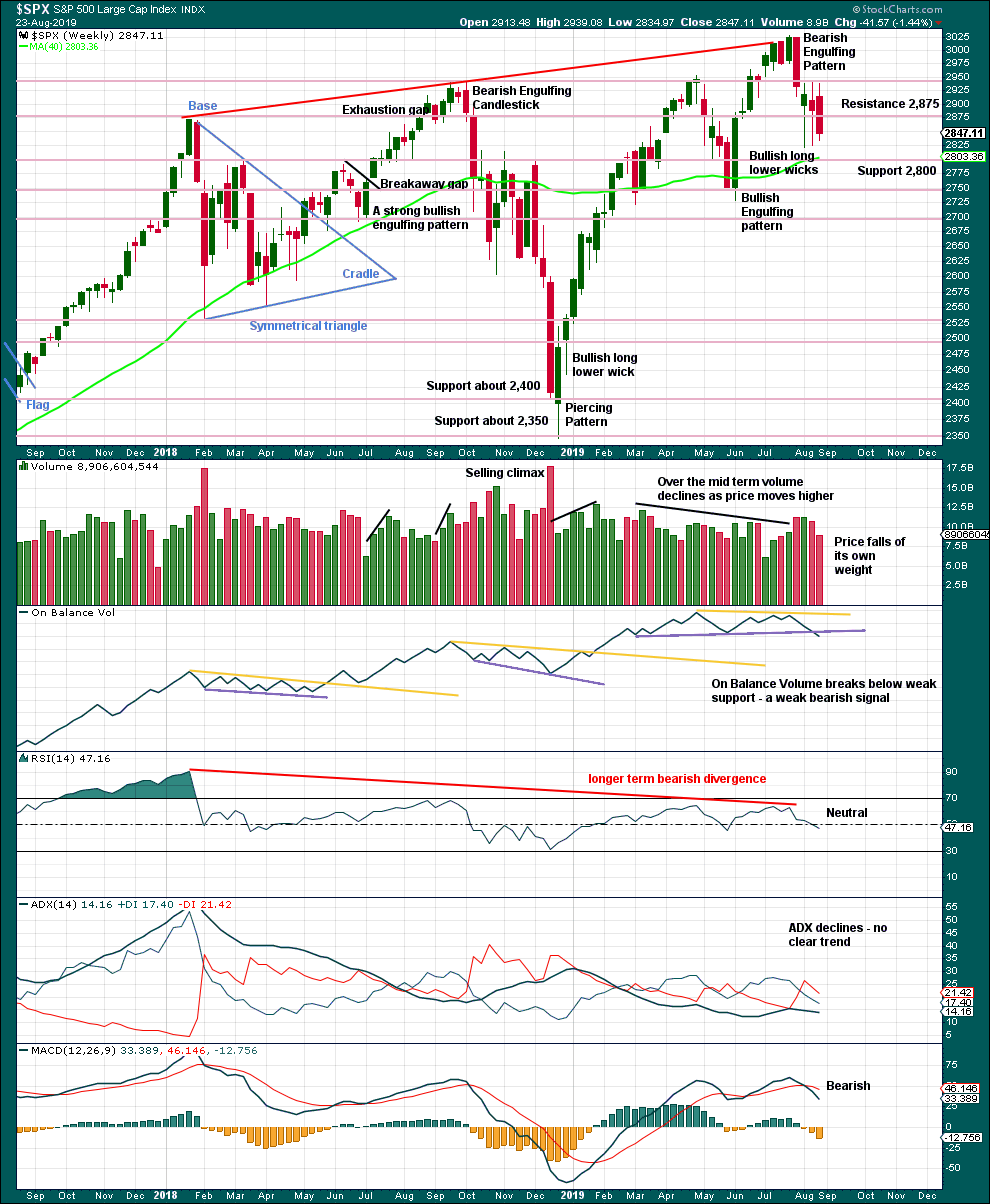
Click chart to enlarge. Chart courtesy of StockCharts.com.
Currently, price is range bound with resistance about 2,945 and support about 2,920.
The larger trend is up from the low in December 2018, with a series of higher highs and higher lows. This upwards trend should be assumed to remain while the last swing low at 2,728.81 remains intact.
The signal from On Balance Volume favours the alternate daily Elliott wave counts.
DAILY CHART
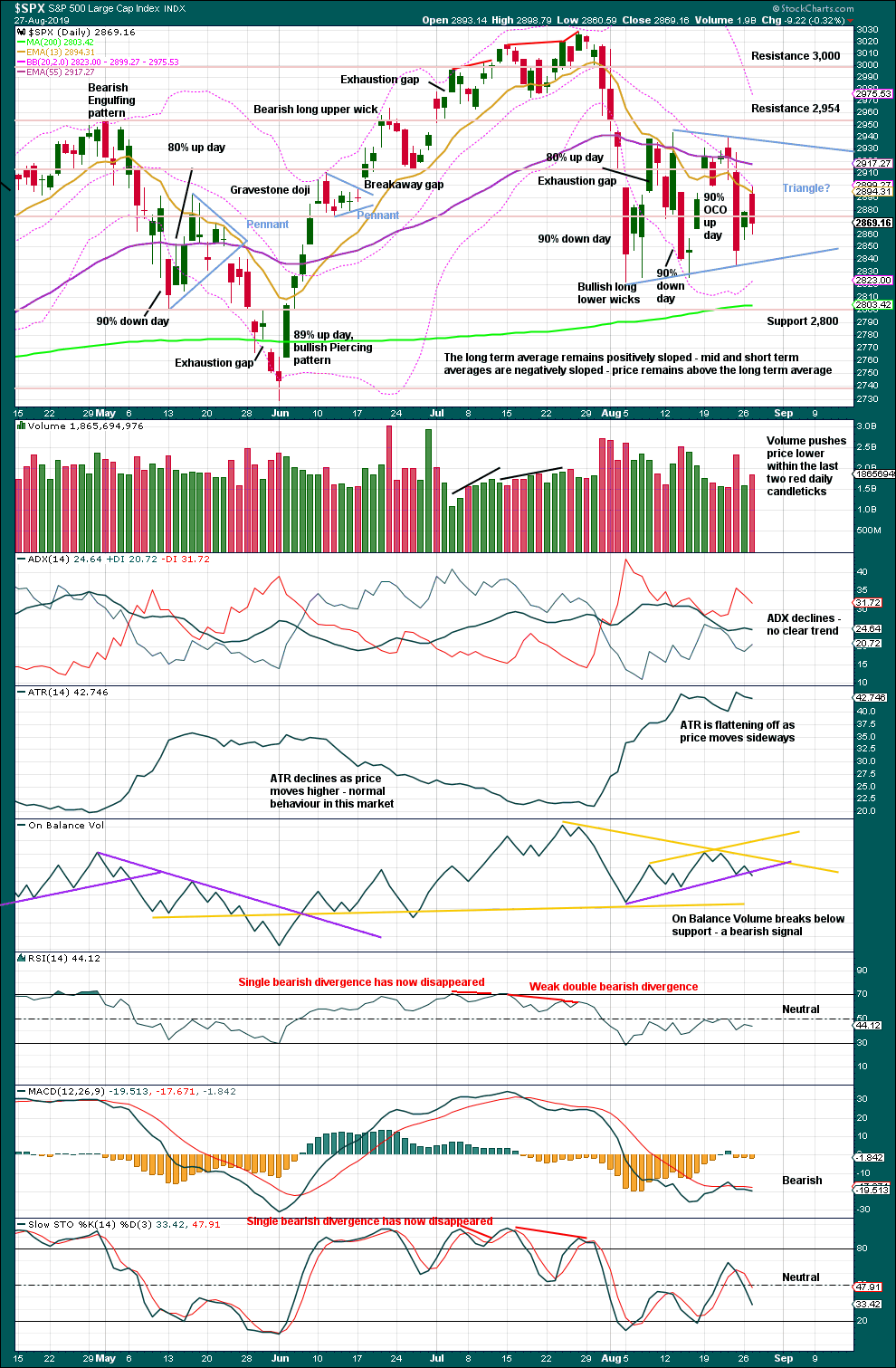
Click chart to enlarge. Chart courtesy of StockCharts.com.
The last low of the 15th of August was preceded immediately by a 90% downward day and followed immediately by a 90% OCO (Operating Companies Only) up day. This is a pattern commonly found at major lows, and it indicates a 180 degree shift in sentiment from bearish to bullish. This favours the main Elliott wave count.
However, the lack of any strength in upwards movement is concerning for this view.
A classic triangle may be completing. Classic triangles have an important difference to Elliott wave triangles. While Elliott wave triangles are always continuation patterns, classic triangles may be either continuation or reversal patterns. A breakout either above or below the triangle trend lines is required before the next direction can be known. At that stage, a target using the triangle width added to the breakout point may be calculated.
Today On Balance Volume gives a bearish signal. This suggests the breakout from the triangle may be downwards. A target would be about 2,720.
The short-term volume profile is now also bearish.
BREADTH – AD LINE
WEEKLY CHART
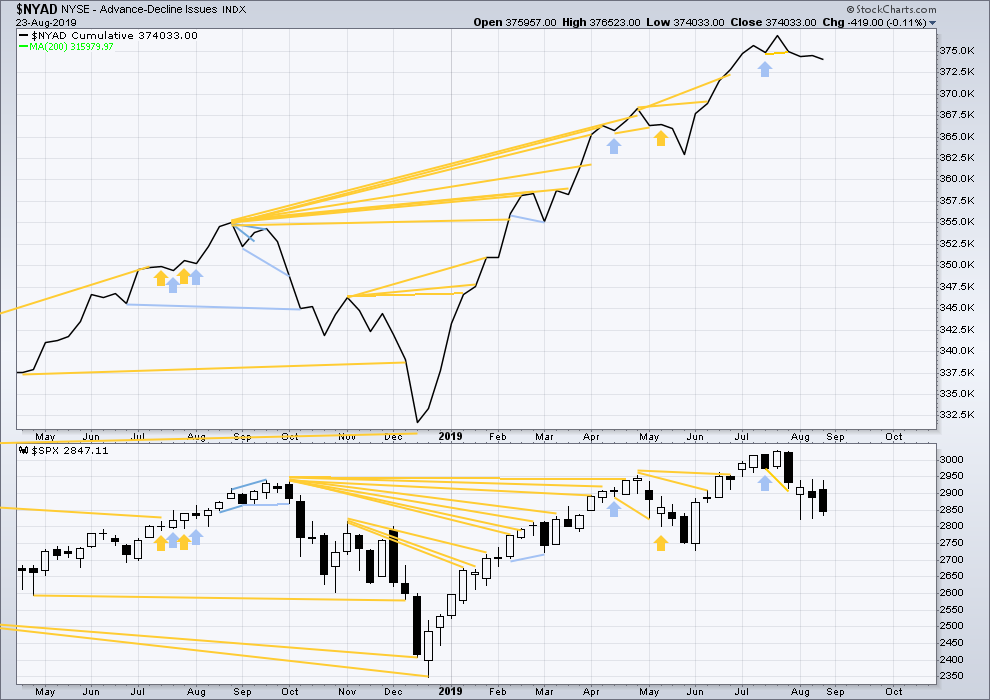
Click chart to enlarge. Chart courtesy of StockCharts.com. So that colour blind members are included, bearish signals
will be noted with blue and bullish signals with yellow.
Bear markets from the Great Depression and onwards have been preceded by an average minimum of 4 months divergence between price and the AD line with only two exceptions in 1946 and 1976. With the AD line making new all time highs again recently, the end of this bull market and the start of a new bear market is very likely a minimum of 4 months away, which is mid November 2019.
In all bear markets in the last 90 years there is some positive correlation (0.6022) between the length of bearish divergence and the depth of the following bear market. No to little divergence is correlated with more shallow bear markets. Longer divergence is correlated with deeper bear markets.
If a bear market does develop here, it comes after no bearish divergence. It would therefore more likely be shallow.
Last week price moved sideways with a red candlestick and the balance of volume downwards. The AD line has slightly declined. There is no new short-term divergence.
DAILY CHART

Click chart to enlarge. Chart courtesy of StockCharts.com. So that colour blind members are included, bearish signals
will be noted with blue and bullish signals with yellow.
Breadth should be read as a leading indicator.
The AD line has made another new high above the prior high of the 13th of August, but price has not. This divergence is bullish and still supports the main Elliott wave count.
Today price moved higher with a higher high and a higher low, but the candlestick has closed red. Downwards movement within the session has support from declining breadth. This divergence is bearish and supports the alternate Elliott wave counts.
VOLATILITY – INVERTED VIX CHART
WEEKLY CHART
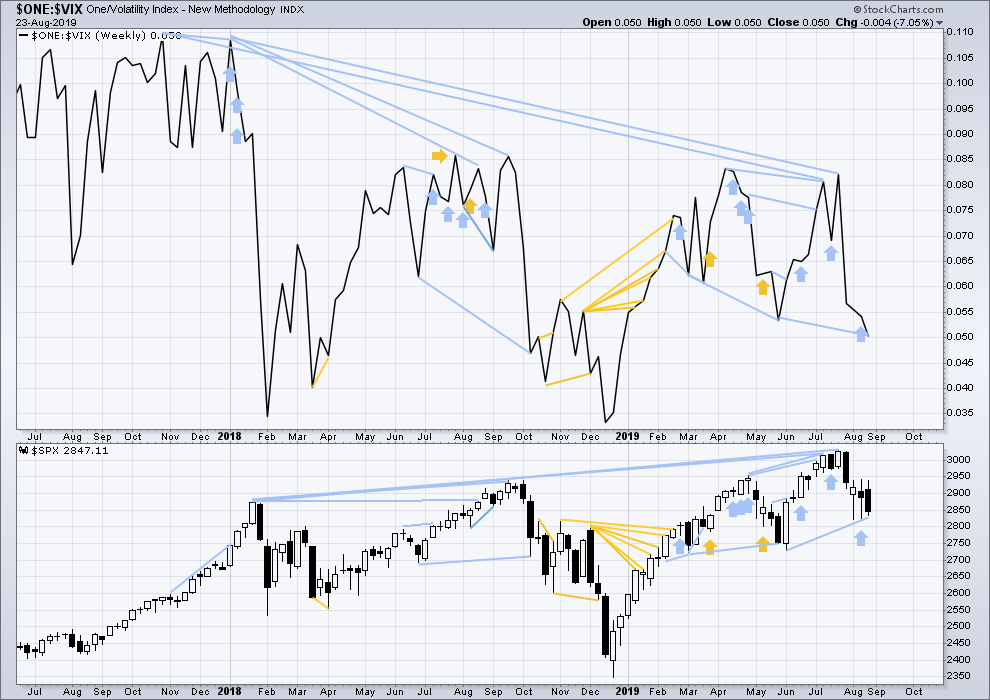
Click chart to enlarge. Chart courtesy of StockCharts.com. So that colour blind members are included, bearish signals
will be noted with blue and bullish signals with yellow.
The all time high for inverted VIX (which is the same as the low for VIX) was on 30th October 2017. There is now nearly one year and nine months of bearish divergence between price and inverted VIX.
The rise in price is not coming with a normal corresponding decline in VIX; VIX remains elevated. This long-term divergence is bearish and may yet develop further as the bull market matures.
This divergence may be an early warning, a part of the process of a top developing that may take years. It may not be useful in timing a trend change.
Last week price moved lower within the week. Inverted VIX has made a new swing low below the prior low of the week of the 28th of May, but price has not. This divergence is bearish and supports the alternate Elliott wave counts; but because it is not confirmed by the AD line, it is given little weight in this analysis. Note that this happened recently with prior divergence between swing lows, which was shortly after followed by upwards movement to the last all time high.
DAILY CHART

Click chart to enlarge. Chart courtesy of StockCharts.com. So that colour blind members are included, bearish signals
will be noted with blue and bullish signals with yellow.
Inverted VIX made a new high above the prior high of the 13th of August, but price has not. This divergence is still bullish and confirms the bullish signal from the AD line. This supports the main Elliott wave count.
Today price has moved higher, but inverted VIX has moved lower. This divergence is bearish. Inverted VIX has made a new low below the low two sessions prior, but price has not; this is also bearish. Because inverted VIX today confirms the signal from the AD line it shall be given some weight in this analysis.
DOW THEORY
Dow Theory confirmed a bear market in December 2018. This does not necessarily mean a bear market at Grand Super Cycle degree though; Dow Theory makes no comment on Elliott wave counts. On the 25th of August 2015 Dow Theory also confirmed a bear market. The Elliott wave count sees that as part of cycle wave II. After Dow Theory confirmation of a bear market in August 2015, price went on to make new all time highs and the bull market continued.
DJIA: 23,344.52 – a close on the 19th of December at 23,284.97 confirms a bear market.
DJT: 9,806.79 – price has closed below this point on the 13th of December.
S&P500: 2,532.69 – a close on the 19th of December at 2,506.96 provides support to a bear market conclusion.
Nasdaq: 6,630.67 – a close on the 19th of December at 6,618.86 provides support to a bear market conclusion.
With all the indices having moved higher following a Dow Theory bear market confirmation, Dow Theory would confirm a bull market if the following highs are made:
DJIA: 26,951.81 – a close above this point has been made on the 3rd of July 2019.
DJT: 11,623.58 – to date DJT has failed to confirm an ongoing bull market.
S&P500: 2,940.91 – a close above this point was made on the 29th of April 2019.
Nasdaq: 8,133.30 – a close above this point was made on the 26th of April 2019.
Published @ 08:48 p.m. EST.
—
Careful risk management protects your trading account(s).
Follow my two Golden Rules:
1. Always trade with stops.
2. Risk only 1-5% of equity on any one trade.
—
New updates to this analysis are in bold.

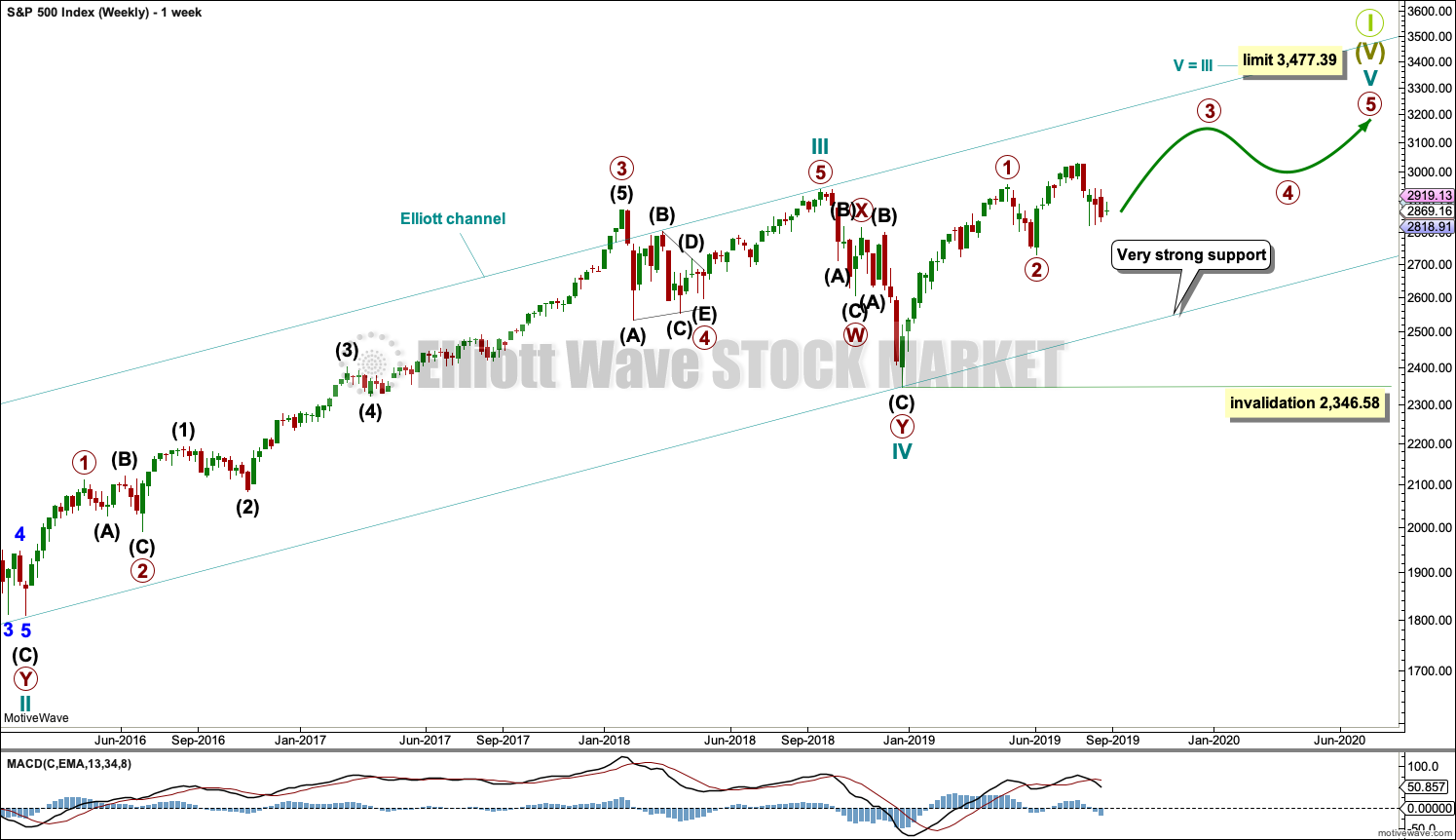
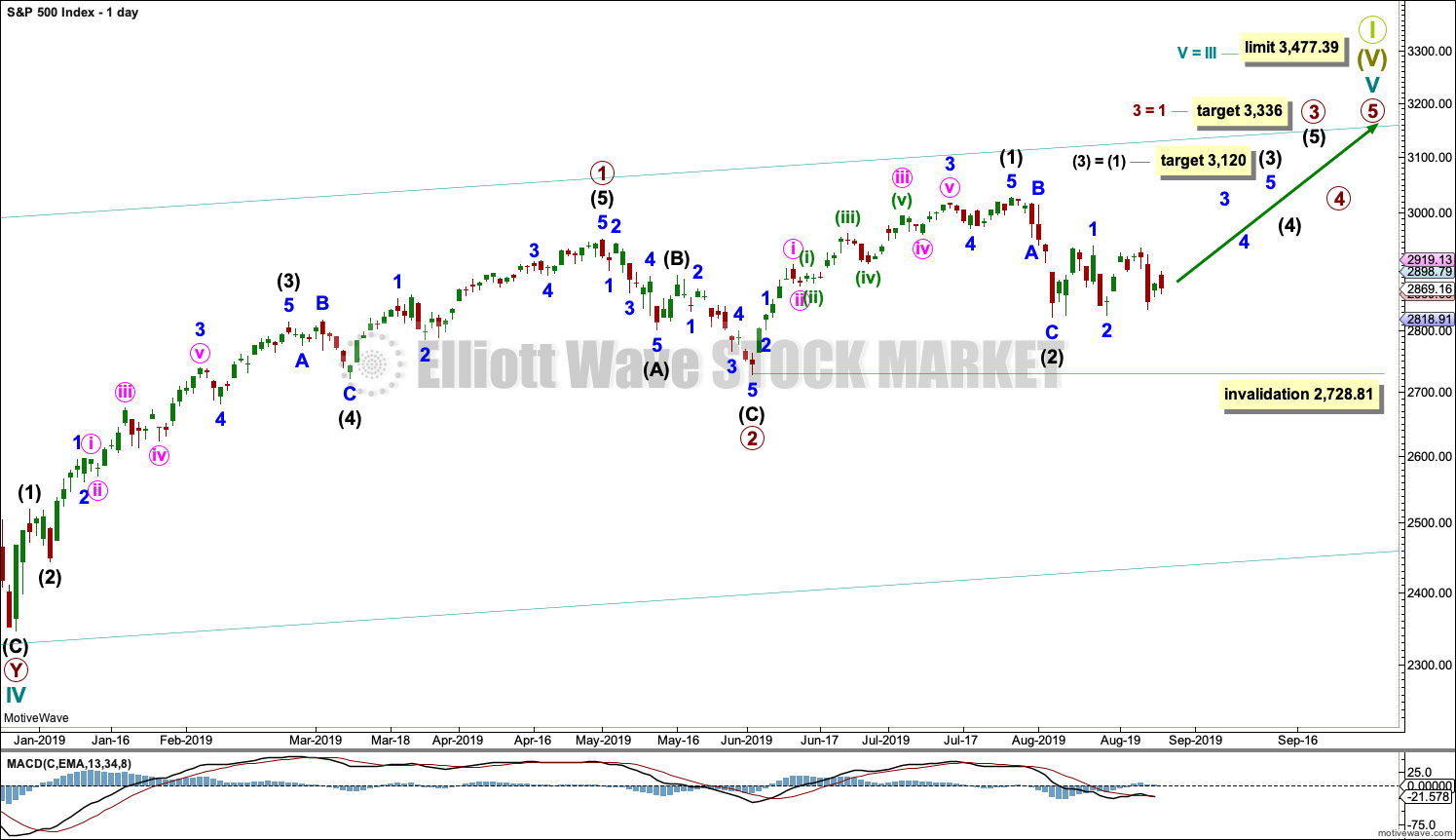
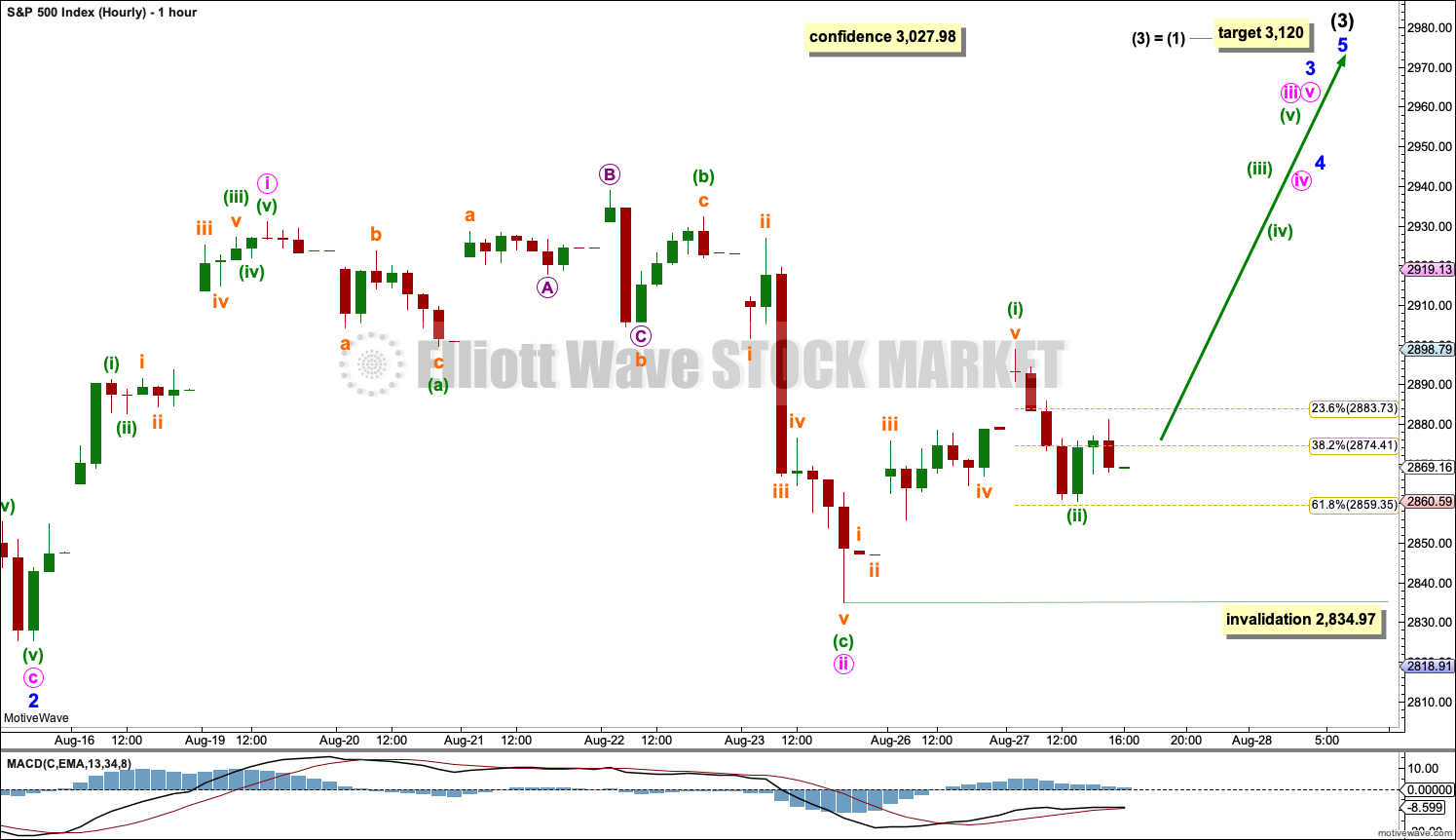
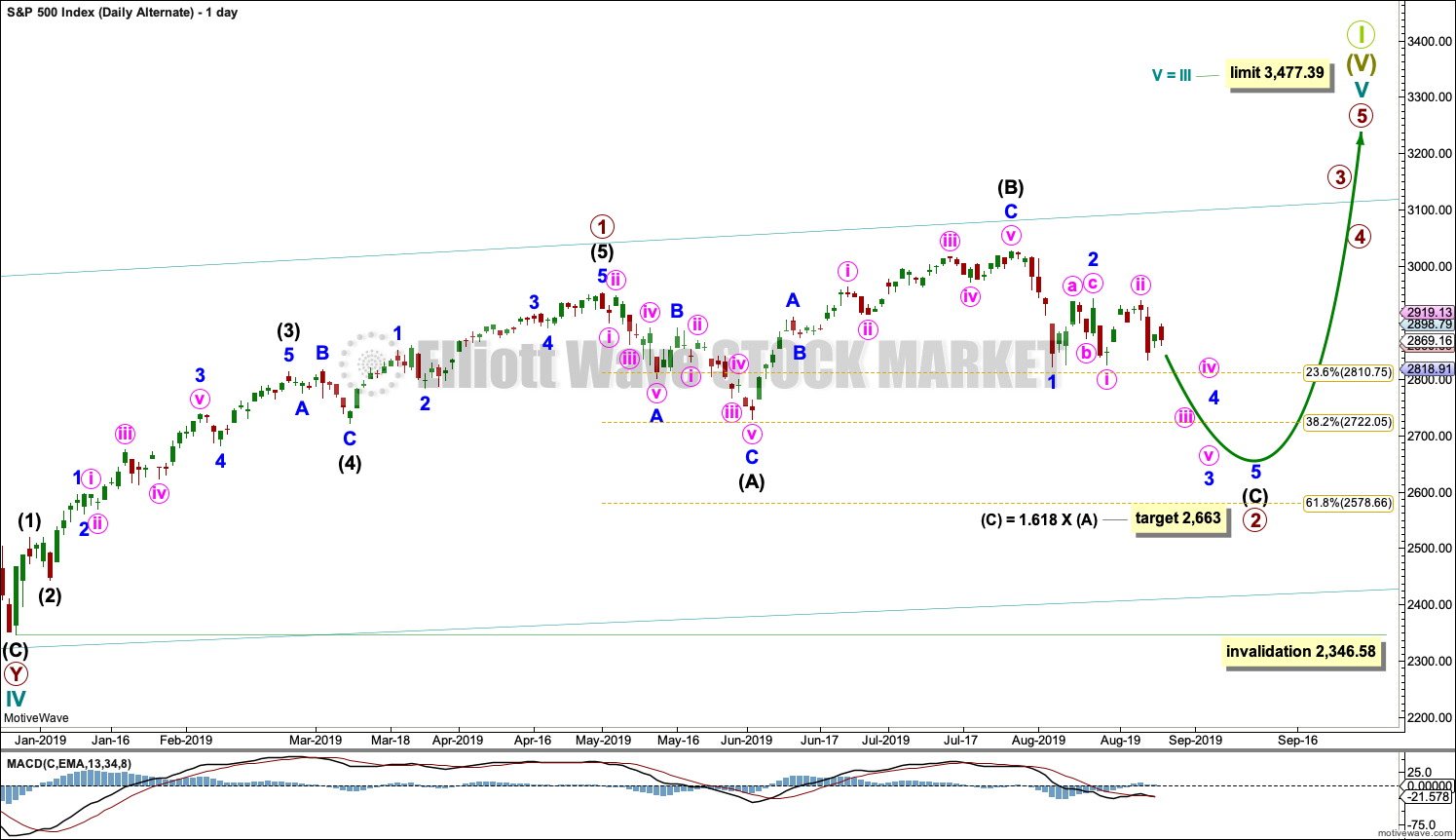
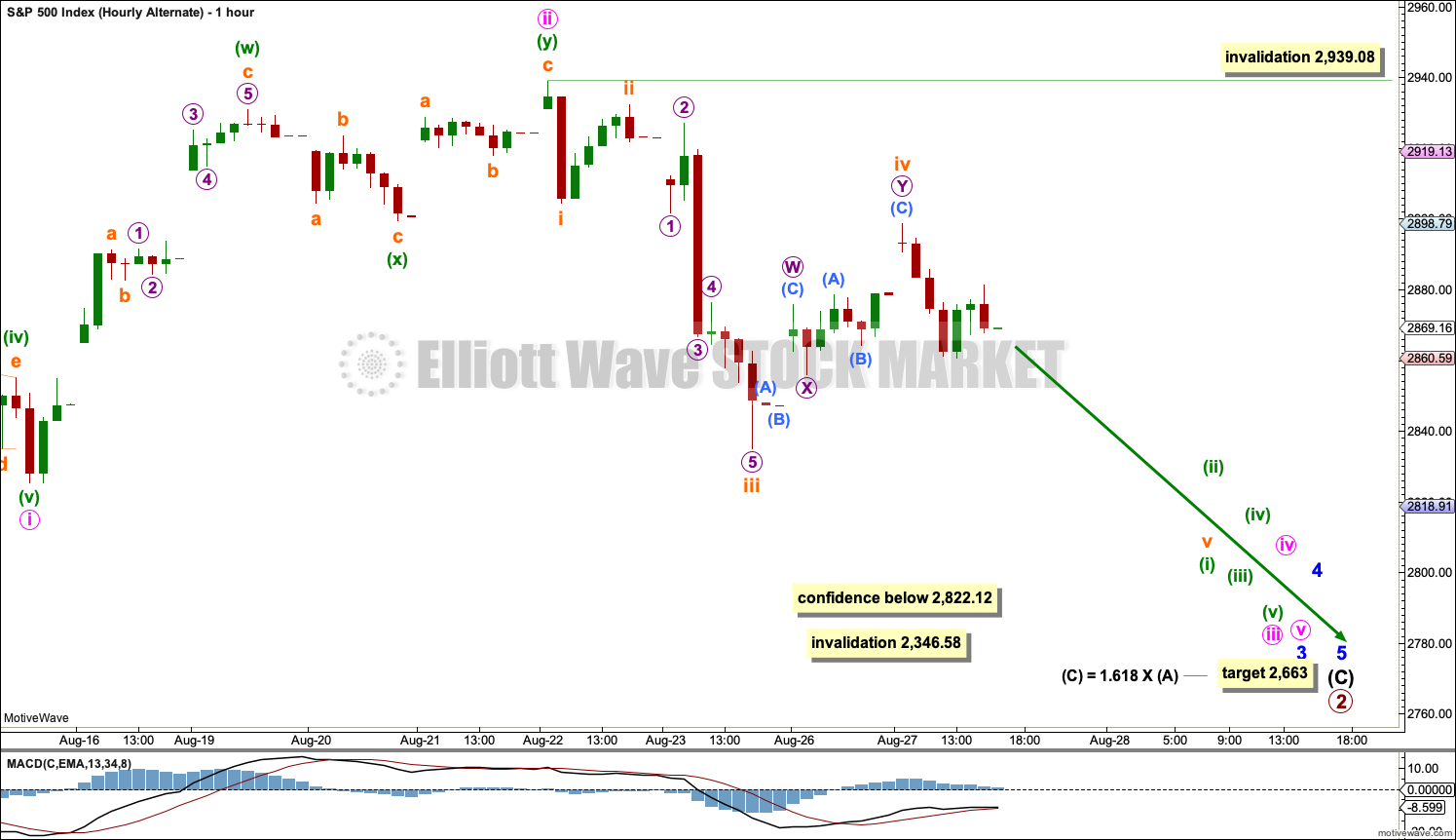
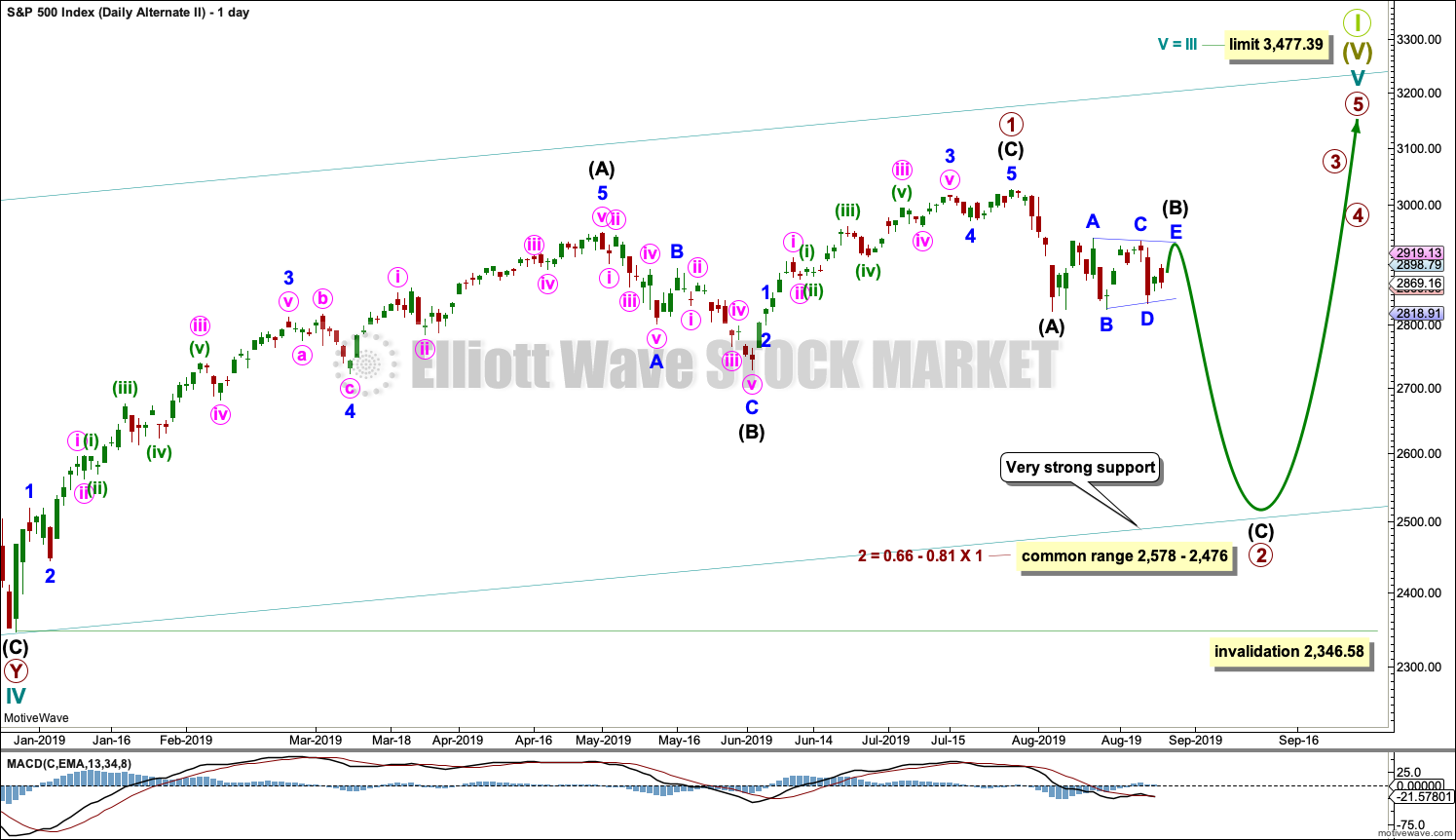
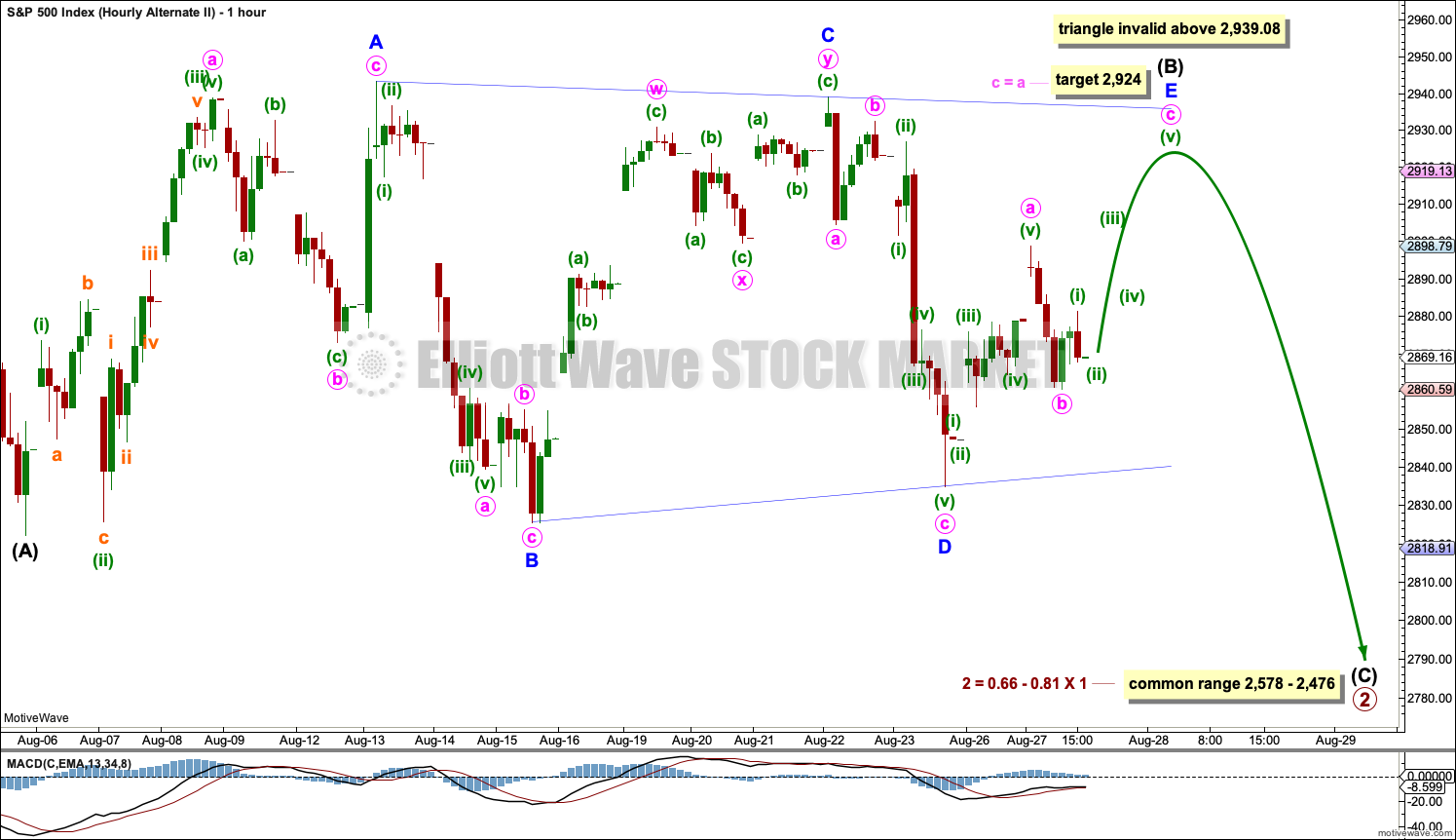
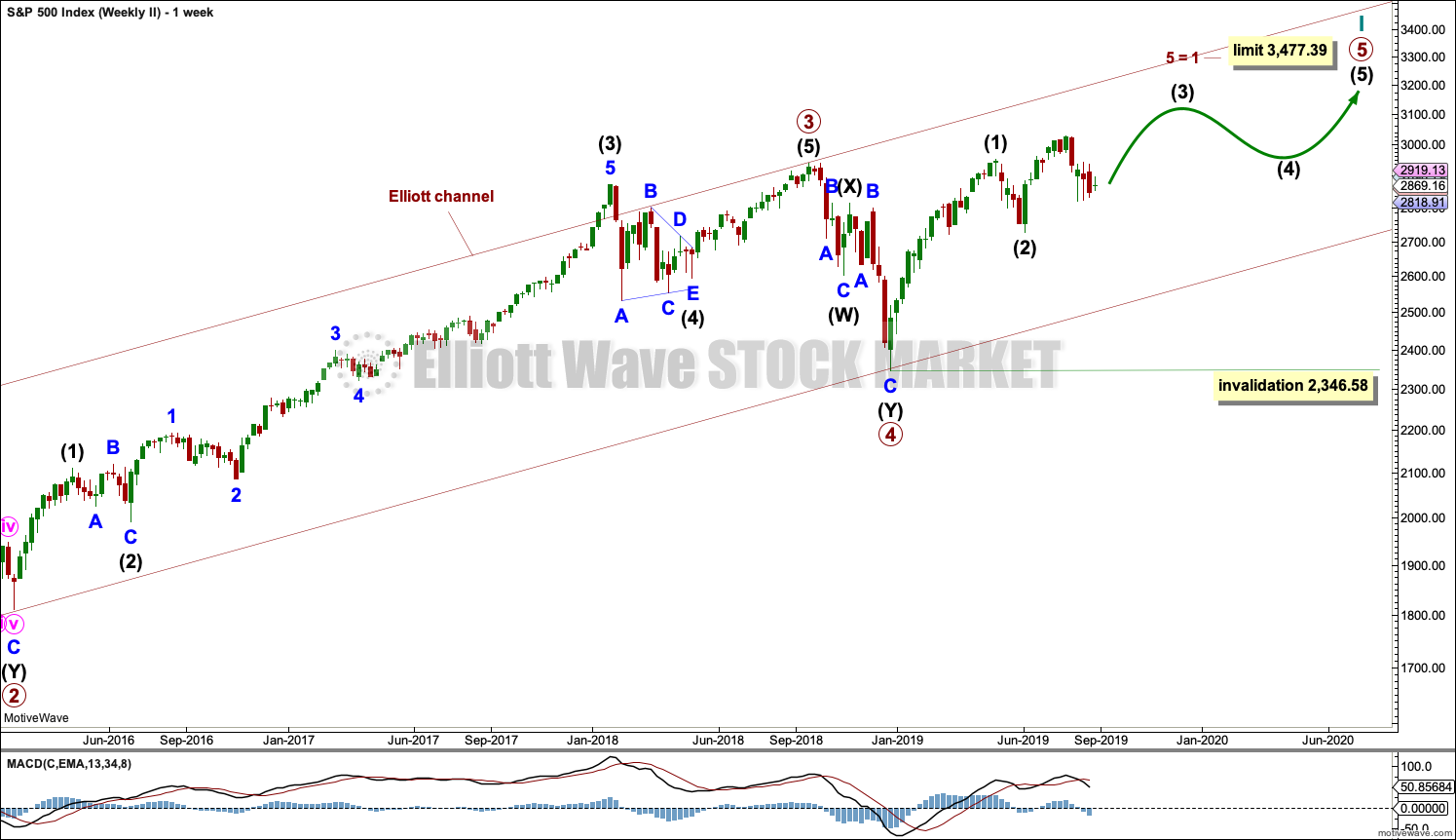
Main hourly chart updated:
Second alternate hourly chart updated
The short term target is recalculated.
Break from sideways coil should be violent.
DJIA moved up to open Aug 13 close…
Waiting patiently for signs of reversal… Things are going north ATM…
Not atypical for initial break from coil to be upwards prior to sharp reversal…pattern suggests a “throw over” should be expected….
GLD has hit the lowest of the 3 targets I projected in mid July. And it’s at the top of a big up channel. And that target perfectly overlaps a key 162% extension level. I’m suspecting a move back down to the range of the prior 4, shown by the two horizontal lines. Waiting for some initially confirming downward price action. Then perhaps a fly down in that zone.
Very thankful for this rally today. My theory is that IWM and DJT lead the market (up or down), and they were oversold, specially IWM. This rally offsets the oversold conditions for it to move lower… time to load up on shorts once again.
Now the question is how high will it go before markets turn again? Or is it ready to turn from here? IWM in the midst of printing shooting star candle on the hourly chart…
Second alternate or main? I am always “bullishly impressed” when SPX opens gap down, pushes up and through, and keeps going. Though in this case of the market churning in the shadow of a huge down candle…not so much. If the big money is distributing, they need to keep doing this to give them time to lighten at good/best prices.
Price hit the 76-78% retrace level going back up, and it’s a high potential spot for a turn back down, IMO.
Looking good so far for my speculative short off this level…
ES 2880-2882 as been formidable resistance/support…
If/when ES breaks this area to the downside, I think it’ll continue lower.
We could meander here for a while for direction…
now approaching those fibo levels for a third time…and in my experience, 3rd times very often leads to break throughs. We’ll see. I’ve managed to break even trying to catch a sell off but none to be had today so far.
if price does move through this level, I expect overall its headed to the 2920’s in fairly short order. The 127% extension of the prior move up, and just below the overall range highs.
i hear you mister. Also volume tends to be light going into a holiday wknd. And usually when volume is low, price tends to go higher…
There are bull flags in shorter time frames, and also a bullish engulfing candle on the ES 4 hour chart from earlier this morning…
All this points to higher prices coming to end this week…
if 2920 does come around, what an opportunity would that be 🙂
There is always a chance though of market reversal going south due to high volatility though… its SOH time!
Well…I just took a long in RUT via IWM calls. I think the hourly is showing pretty good bottom structure, and there’s room to move up in side this range, even if price doesn’t ultimately escape it.
looks like a bull flag to me! Good move 🙂
I’m a bit too timid to open long positions since at any time we can have a waterfall sell off… so short positions only for me ATM…
Also long NDX via TQQQ…
Next immediate battle-ground 2840…
Stocks generated an unprecedented third Hindenburg Omen on Tuesday, Aug 27.
We had two on the clock last fall…interesting times ahead…
Verne, as I understand the Hindenburg Omen, the first confirmation condition is that the 10 week moving average of the NYSE must be rising. If not, the signal is not valid. In checking this, I have noted that the 10 week moving average of NYSE turned down the week ending 8/16 and is downward sloping now thus invalidating the signal. Of course, this does not in any way mean the market is in a bullish condition.
“Standin’ on top, of the world!”
You’re just breaking my heart!
Drat! The cold streak continues.
Number uno 🙂
Winner by a Fibonacci 8 + 1
Interesting in that when I showed up last evening, your post was not visible. On;y Kevin’s post was showing. I do not know how you did it. But congratulations Rishi!
And it’s Rishi from out of nowhere!!! But wait, oh no, server timestamp controversy, start up the congressional investigation! “I was robbed!!”
LMAO!